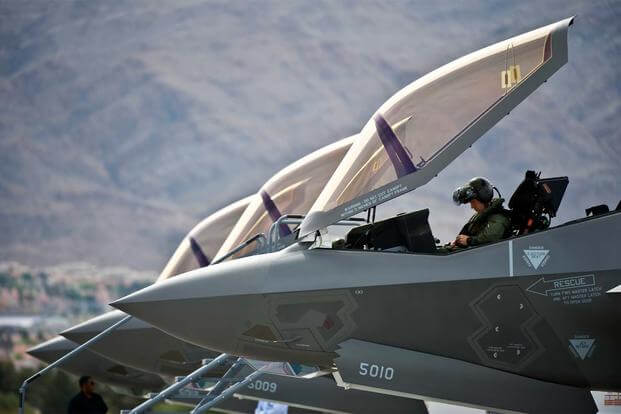More than a dozen Air Force F-35 pilots experienced oxygen deprivation symptoms between 2011 and this year, the service disclosed Thursday as it investigates a steady uptick of hypoxia-related incidents at Luke Air Force Base, Arizona.
It marked the first time many of the cases had been disclosed publicly.
In a statement Thursday, Air Force spokesman Capt. Mark Graff said that since April 2, 2011, there "have been 15 reported F-35A in-flight and ground physiological events."
"Five of those events were reported by Luke Air Force Base pilots between May 2 and June 8th, 2017," Graff said in an email. "In all cases, pilots were able to safely recover the aircraft via established procedures."
Related content:
- F-35s Grounded at Luke AFB After Pilots Report Hypoxia-Like Symptoms
- F-35As Still Grounded at Luke Air Force Base
- Air Force Grounds 13 F-35s It Deemed Ready for War
Graff said that the 10 previous cases were considered isolated incidents because they were not regular occurrences at a frequent rate. However, there were far fewer F-35s -- a model designed for taking off and landing on conventional runways -- in the Air Force's inventory during that timeframe.
"Overall, physiological events occur at low rates in all Air Force aircraft," Graff said. "The Air Force reviews all physiological events to learn from them and to ensure the safety and well-being of our pilots."
The service is maintaining a temporary suspension of all F-35 flights at Luke until further notice, officials said this week.
The 56th Fighter Wing at the base halted operations for all F-35As there after pilots recently complained of hypoxia-related issues.
"The 56th Fighter Wing will continue their pause in local F-35A flying to coordinate analysis and communication between pilots, maintainers, medical professionals and a team of military and industry experts," Luke spokeswoman Maj. Rebecca Heyse said in a statement Monday.
Graff did not say whether the service is any closer to pinpointing the issue, nor if the earlier cases have shed light on the recent incidents at Luke.
Senate Armed Services Committee Chairman Sen. John McCain issued a statement on the Luke F-35A stand-down Wednesday, concerned for operations in his home state.
"I am in close communication with Air Force officials as they continue to conduct a technical analysis of the F-35A program at Luke Air Force Base, which has been suspended following reports of physiological incidents in recent weeks," he said. "I share the concerns of our military commanders, and believe it is critical they identify the root cause of these incidents and take the necessary steps to ensure our pilots return to safe flying operations.
"I appreciate the careful work by the team of engineers, maintainers and aeromedical specialists examining this issue, and will continue to monitor their work so we can protect the safety and well-being of our brave airmen training at Luke Air Force Base," McCain added.
Since May 2, five F-35A pilots have experienced physiological incidents while flying. In each case, the aircraft's backup oxygen system kicked in and the pilot followed the correct procedures to land safely, officials have said.
A total of 55 F-35As are assigned to Luke.
Base officials educated pilots on the effects of hypoxia last Friday, Graff said. Now, there will be "continued analysis of the incidents, and [officials will] fuse that with more information as they go about it. The incidents are the crux of the issue," he said.
There have been no additional reports from pilots suffering similar symptoms, Graff said.
The issue of military pilots suffering hypoxia-like symptoms -- shortness of breath, confusion, wheezing -- in-flight isn't limited to the F-35 fleet.
Pilots flying the F-22 Raptor fifth-generation stealth jet experienced hypoxia symptoms on various occasions between 2008 and 2012. One pilot died as a result, and one had a near-death scare, with dozens more pilots experiencing confusion and disorientation while flying, according to an ABC News investigation at the time.
Then-Pentagon spokesman George Little said investigators found the cause to be a faulty valve in the high-pressure vest worn by the pilots at extreme altitude, which was restricting their ability to breathe.
More recently, the Navy went so far as to equip the aircraft carrier USS George H. W. Bush with specialized equipment called a transportable recompression system, or hyperbaric chamber, amid a review of physiological episodes affecting pilots who fly the T-45 trainer and the F/A-18 Hornet.
Dan Ward, a former engineering officer and retired Air Force lieutenant colonel, in a 2015 opinion piece for the website "War is Boring," wrote that like its stealth jet predecessors, the F-35 will likely experience similar hypoxia setbacks.
"Forget the enormous cost overruns. Excuse the epic schedule delays. Overlook the disturbing performance limitations. … It comes down to a single word -- hypoxia," Ward said at the time.
"The likelihood of the JSF displaying a flaw similar to the F-22's is high because the JSF is just as complex as the F-22, if not more so, and all that complexity tends to hide bugs and problems and flaws," he said.
-- Oriana Pawlyk can be reached at oriana.pawlyk@military.com. Follow her on Twitter at@Oriana0214.
Related Video:






























